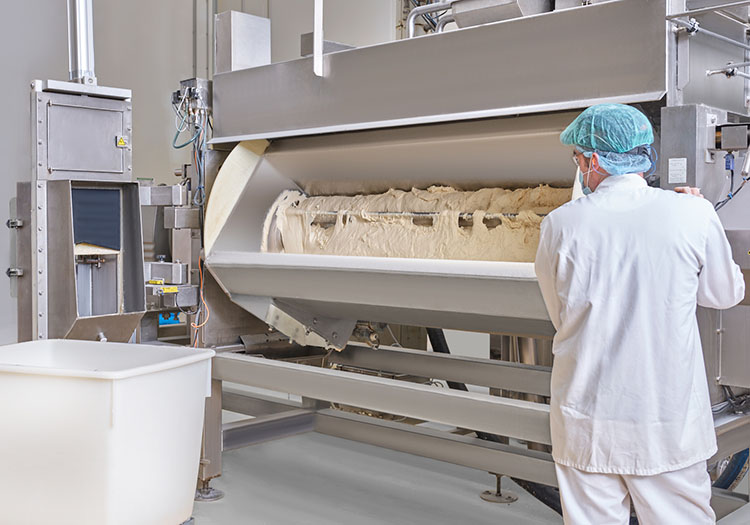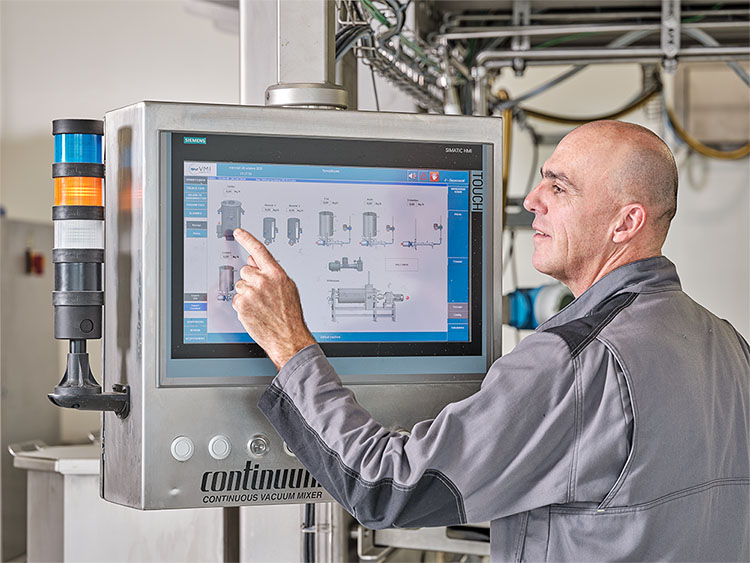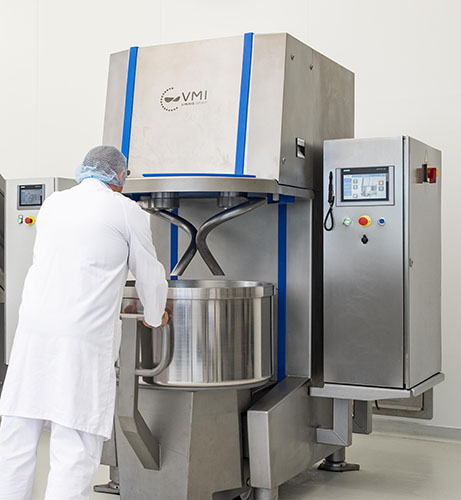
Precision mixing technology brings undeniable benefits to consistently forming dough exactly as needed, time after time. When choosing the optimum equipment to perfect the process, technologies for batch and continuous mixing can bring the best-suited functionalities for each product range, manufacturing plant and operation.
Continuous or batch mixers? The answer is not a simple, linear, ‘either/or’ choice, when choosing the best fit for a range of products, a production line – or several, a baking facility, or a network. There is a strong case that justifies each, in any given (baking) circumstance.
Continuous mixing machines excel in delivering consistent results. They are the technology of choice for forming raw, par-baked and frozen dough, and are not only often seen in the production of bread and baguettes but also puff pastry, and Viennese pastry, where their cooling capacity is especially beneficial. “Continuous mixers, such as our Verymix, are valued for their ability to ensure consistency and stability in single-product operations,” VMI elaborates.
Cookies, anyone?
However, their versatility extends further, considering that various technologies are perfected for continuous mixing. For instance, continuous vacuum mixers, such as VMI’s Continuum range, can also be used to process dough for soft products such as sandwich breads. Further developments are underway: “We are also exploring new applications with the Continuum, such as biscuit/cookie production,” VMI highlights – although there are several established reasons why batch mixing remains the traditional choice in segments such as biscuits and cookies.
One key factor as to why batch mixers make sense in cookie production is the nature of the dough, which tends to be less structured compared to bread dough, for instance. Continuous mixing systems need to work with dough that is well-bound for peak performance that facilitates smooth circulation within the mixing tank. However, it is possible to use a continuous mixing technology to make biscuits and cookies, VMI believes; several successful trials have already confirmed the hypothesis.
“Batch mixers with removable bowls also excel in the efficient management of the different dough processing phases, such as resting periods and autolysis.”
VMI specialists
Another reason why batch mixers are a tried and tested, valid choice for these applications is the flexibility they offer for recipe changeovers. Batch mixers with removable bowls are especially well-suited for fast handling, making them a widely popular choice, particularly for the production of biscuits and cookies: “One key aspect is the ease of changing production setups, allowing for quick transitions between different products. When considering batch mixers, there are various configurations available, including automated, semi-automated, or manual configurations. This allows for adaptation of the process to meet the customer’s needs, budget, and desired level of flexibility,” VMI illustrates. Batch mixers with removable bowls also excel in the efficient management of the different dough processing phases, such as resting periods and autolysis. “This versatility empowers producers to customize their processes according to specific recipes or production requirements,” the French specialist explains.
Match and mix
Looking at their different needs in terms of teams, resources and end products, continuous mixing will require a learning curve for the staff when first adopted, as it is not yet as widely used as batch mixing. However, it is a highly efficient technology once assimilated. Moreover, it is nimble regarding resource requirements, with most processes being automated. Batch mixing systems, by contrast, define the level of resources needed to operate according to their level of automation in the line: manual systems need substantial resources, while fully automated setups have considerably lower needs.
The end product manufactured plays a decisive role in the choice of mixing technology. It should be noted, however, that there is no one-size-fits-all solution in this regard, even if certain technologies may be recommended for specific products. The choice of the technology to use largely depends on the operation’s requirements, the desired quality of the dough, and the characteristics of the end product.
Comparing the mixing process for batch and continuous mixers is a challenging enterprise, even when looking at similar production volumes and products, as it can vary significantly on each production floor. Several parameters may differ, including the volume of the mixer, the number of bowls, the automation level and mixing tools, for example. “But, it is entirely possible to present two offers to the same customer for the same product and requirements – one using batch mixers and the other using continuous mixers,” VMI underlines. The specific needs and priorities of each operation will determine the technology of choice.
Among factors that often steer the choice towards continuous mixers, VMI observes:
+ The need for high-level stability and regularity in dosing ingredients, that minimizes the risk of human error and ensures product uniformity;
+ Consistency in product quality;
+ Easy operation with precise dosing and a highly regular output;
+ Cooling capacity: continuous mixers can cool the dough during the process due to the large contact zone between the dough and the double-jacketed tank with glycol circulation.
Alternatively, factors that favor the choice of batch mixers usually include:
+ Batch mixers offer greater flexibility, allowing for easy adjustments in production setup, especially when producing a large range of products;
+ Automated systems with batch mixers can be equipped with Clean-in-Place (CIP) systems, simplifying the cleaning process of the bowl;
+ They can handle a wide array of different ingredients, accommodating a diverse range of products. On continuous mixers, since dosing is automated, a dosing unit will be needed for each ingredient in the recipe, even minor ingredients, which brings additional cost- and space-related considerations into the equation;
+ Most batch mixers only limit dough heating, they do not cool the dough – only some models offer this feature.
However, there is no major difference in terms of productivity or production rate as this will entirely depend on the process and equipment chosen, the French specialist highlights.
Cleaning and maintenance will also vary for each type of technology. Continuous mixers like the Verymix offer a mobile Clean-in-Place (CIP) system that allows the liquid dosing units to be cleaned efficiently. The tank requires manual cleaning, but the stainless steel bowl is easy to clean. Additionally, continuous mixers have minimal wearing parts, making maintenance straightforward.

Automated batch mixing systems, on the other hand, may include CIP to clean the bowls, streamlining cleaning processes. However, cleaning mixing tools manually might still be necessary for recipe changes, VMI observes. Maintenance will depend on the specific technology and the process (i.e., the type of dough, mixing duration, etc.).
Looking at the bigger picture, the production facility itself and its setup should also be carefully considered when choosing a mixing technology, VMI recommends: “Batch mixers with removable bowls offer flexibility, especially in semi-automated setups, making them adaptable to various environmental constraints. They integrate well into existing workflows and allow for easy scalability by adding more mixers to increase production capacity. Conversely, the compactness of continuous mixers depends on the recipe and the number of dosing units required. Recipes with numerous ingredients, such as Viennese pastry, may require many dosing units, affecting the system’s footprint.”
Planning ahead: the continuous mixing route
Continuous mixing is particularly adapted and often highly efficient for single-product productions. However, when manufacturers decide on new investments, they may hesitate to opt for this technology, VMI observes, even in cases where it appears to be more beneficial than batch mixing. Unfamiliarity with the technology is often the underlying cause: “For example, production teams might hesitate to switch from batch mixing to continuous mixing due to the potential disruption of their working habits and familiar manufacturing practices, despite the ultimate efficiency of the solution. This underscores the crucial need for dedicated support throughout the transition process,” VMI explains.
Without a doubt, continuous mixing technology is surging in popularity. Consequently, it is also expanding into new applications, a prime example being in the production of donuts. “This technology offers unparalleled consistency and is especially efficient for products that require careful fermentation control,” VMI concludes.

Both processes under control
Process control is paramount to ensuring consistent results, for any production setup. Both batch and continuous mixing technologies can incorporate process controls through Human-Machine Interface (HMI) systems. However, continuous mixers often offer more precise and comprehensive control as they fully automate the process, from dosing to pre-mixing and mixing. In this way, consistency and accuracy are ensured throughout the entire mixing process.
In turn, batch mixers may also feature advanced process controls, especially when looking at automated systems, which allow precise monitoring and adjustment of parameters; process control capabilities will largely depend on the level of automation in the line, in this case. “When batch mixing systems are not fully automated, it is common for the dosing part to be separated from the main system. This means that the dosing control may not be integrated into the batch mixing system itself, leading to potential variations in ingredient proportions,” VMI illustrates.
It is a complex decision-making process, with many variables to be taken into consideration. However, the goal of achieving high-end results remains constant.


